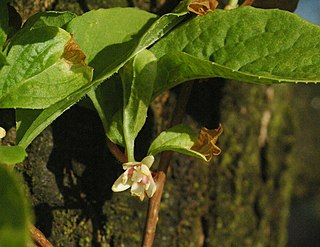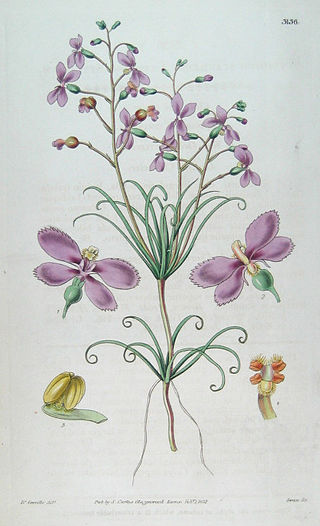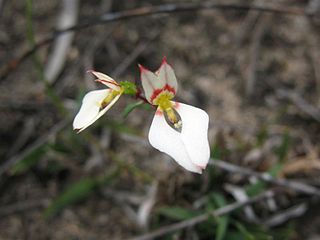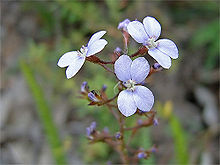
Asterales is an order of dicotyledonous flowering plants that includes the large family Asteraceae known for composite flowers made of florets, and ten families related to the Asteraceae. While asterids in general are characterized by fused petals, composite flowers consisting of many florets create the false appearance of separate petals.

Campanulales is a valid botanic name for a plant order. It was used in the Cronquist system as an order within the subclass Asteridae in the class Magnoliopsida flowering plants. As then circumscribed it included the families:

Geraniales is a small order of flowering plants, included within the rosid subclade of eudicots. The largest family in the order is Geraniaceae with over 800 species. In addition, the order includes the smaller Francoaceae with about 40 species. Most Geraniales are herbaceous, but there are also shrubs and small trees.

Hamamelidaceae, commonly referred to as the witch-hazel family, is a family of flowering plants in the order Saxifragales. The clade consists of shrubs and small trees positioned within the woody clade of the core Saxifragales. An earlier system, the Cronquist system, recognized Hamamelidaceae in the Hamamelidales order.

The Primulaceae, commonly known as the primrose family, are a family of herbaceous and woody flowering plants including some favourite garden plants and wildflowers. Most are perennial though some species, such as scarlet pimpernel, are annuals.

Asphodelaceae is a family of flowering plants in the order Asparagales. Such a family has been recognized by most taxonomists, but the circumscription has varied widely. In its current circumscription in the APG IV system, it includes about 40 genera and 900 known species. The type genus is Asphodelus.

Stylidium is a genus of dicotyledonous plants that belong to the family Stylidiaceae. The genus name Stylidium is derived from the Greek στύλος or stylos, which refers to the distinctive reproductive structure that its flowers possess. Pollination is achieved through the use of the sensitive "trigger", which comprises the male and female reproductive organs fused into a floral column that snaps forward quickly in response to touch, harmlessly covering the insect in pollen. Most of the approximately 300 species are only found in Australia, making it the fifth largest genus in that country. Triggerplants are considered to be protocarnivorous or carnivorous because the glandular trichomes that cover the scape and flower can trap, kill, and digest small insects with protease enzymes produced by the plant. Recent research has raised questions as to the status of protocarnivory within Stylidium.

Schisandraceae is a family of flowering plants with 3 known genera and a total of 92 known species. Such a family has been recognized by most taxonomists, at least for the past several decades. Before that, the plants concerned were assigned to family Magnoliaceae and Illiciaceae.

Theophrastoideae is a small subfamily of flowering plants in the family Primulaceae. It was formerly recognized as a separate family Theophrastaceae. As previously circumscribed, the family consisted of eight genera and 95 species of trees or shrubs, native to tropical regions of the Americas.
Pentaphylax is a genus of flowering plants, with one or two species which are shrubs and small trees. The species has simple evergreen leaves that are alternately arranged on the stems. The flower pistil is 5 celled and the anthers dehiscing via pores and basifixed. Flowers have five petals and five sepals that are distinct from each other and five stamens attached oppositely to the sepals. The seeds are winged.

Oreostylidium is a genus of flowering plants in the family Stylidiaceae with a single species, Oreostylidium subulatum, that is endemic to New Zealand. O. subulatum is a very small plant with small, white flowers. It has a complicated botanical history that has led to a few proposals to move Oreostylidium to the related genus Stylidium. The researchers cite molecular data and suspect that this species is an extreme example of floral paedomorphosis. This would not be an unprecedented move since the single species was initially described as Stylidium subulatum in 1864 and later moved to its own genus by Sven Berggren in 1878. It possesses the same kind of glandular trichomes underneath the flower that make Stylidium species carnivorous plants, but it has not yet been tested for the presence of digestive enzymes.

Donatia is a genus of two cushion plant species in the family Stylidiaceae. The name commemorates Vitaliano Donati, an Italian botanist.

Tolypangium is a subgenus of the genus Stylidium that is characterized by ovoid to longish capsules. This subgenus was part of the earliest taxonomic division among the triggerplants. Stephan Ladislaus Endlicher first split the genus into two subgenera in 1838: Tolypangium with its ovoid capsules and Nitrangium with its linear capsules. Subsequent authors generally followed this classification, which is based almost entirely on the features of the capsule. Recent genetic analysis, combined with an exhaustive morphological comparison, has revealed that the classification defined by Johannes Mildbraed in 1908 is not the most accurate description of how the members of different subgenera and sections are related. As part of the Flora of Australia series, Juliet Wege will be reviewing and updating the taxonomy of the Stylidiaceae.

Verticillatae is a section in the subgenus Tolypangium that is characterized by globose capsules. Recent genetic analysis, combined with an exhaustive morphological comparison, has revealed that the classification defined by Johannes Mildbraed in 1908 is not the most accurate description of how the members of different subgenera and sections are related. As part of the Flora of Australia series, Juliet Wege will be reviewing and updating the taxonomy of the Stylidiaceae.

Levenhookia, also known as the styleworts, is a genus of ten recognized species in the family Stylidiaceae and is endemic to Australia. The genus is restricted to Western Australia almost exclusively with a few exceptions: L. pusilla's range extends into South Australia, L. dubia's range extends through South Australia into Victoria and New South Wales, L. sonderi is native only to Victoria, and L. chippendalei is also found in the Northern Territory.

Levenhookia sect. Coleostylis is a section of four recognized species in the family Stylidiaceae. It was established and described by Johannes Mildbraed in 1908 to separate the subgeneric taxonomy in the genus Levenhookia. Mildbraed originally placed L. preissii and L. stipitata in this section. L. chippendalei was described in 1966 and placed in this section by Rica Erickson and Jim Willis. Section Coleostylis could also contain L. octomaculata, which Erickson described in 1956, noting its affinities with L. stipitata but without placing it in a section. Otherwise it would be unplaced as to a section.

Forstera is a genus of small perennial plants in the Stylidiaceae family named in honour of the German naturalists Johann Reinhold Forster and his son, Georg Forster, who had previously described Forstera's sister genus, Phyllachne just five years earlier. It comprises five species that are endemic to New Zealand with the exception of F. bellidifolia, which is endemic to Tasmania. The species in this genus resemble those in a subgenus of the related genus Stylidium called Forsteropsis, but they are more closely related to the genus Phyllachne. Proposals to merge the two genera based on information from cladistic analysis have emerged because of these genera's morphological similarities and evidence that they are paraphyletic.

Forstera bellidifolia, the Tasmanian forstera, is a species in the family Stylidiaceae that is endemic to Tasmania, Australia. It was described by William Jackson Hooker in an 1851 volume of Icones Plantarum. It is notably different from other members of the genus in that it is not native to New Zealand nor does it possess the epigynous nectaries that are present in the other species.

Donatia novae-zelandiae is a species of mat-forming cushion plant, found only in New Zealand and Tasmania. Common names can include New Zealand Cushion or Snow Cushion, however Snow Cushion also refers to Iberis sempervirens. Donatia novae-zelandiae forms dense spirals of thick, leathery leaves, creating a hardy plant that typically exists in alpine and subalpine bioclimatic zones.

The taxonomy of the plant family Liliaceae has had a complex history since its first description in the mid-eighteenth century. Originally, the Liliaceae were defined as having a "calix" (perianth) of six equal-coloured parts, six stamens, a single style, and a superior, three-chambered (trilocular) ovary turning into a capsule fruit at maturity. The taxonomic circumscription of the family Liliaceae progressively expanded until it became the largest plant family and also extremely diverse, being somewhat arbitrarily defined as all species of plants with six tepals and a superior ovary. It eventually came to encompass about 300 genera and 4,500 species, and was thus a "catch-all" and hence paraphyletic. Only since the more modern taxonomic systems developed by the Angiosperm Phylogeny Group (APG) and based on phylogenetic principles, has it been possible to identify the many separate taxonomic groupings within the original family and redistribute them, leaving a relatively small core as the modern family Liliaceae, with fifteen genera and 600 species.

















